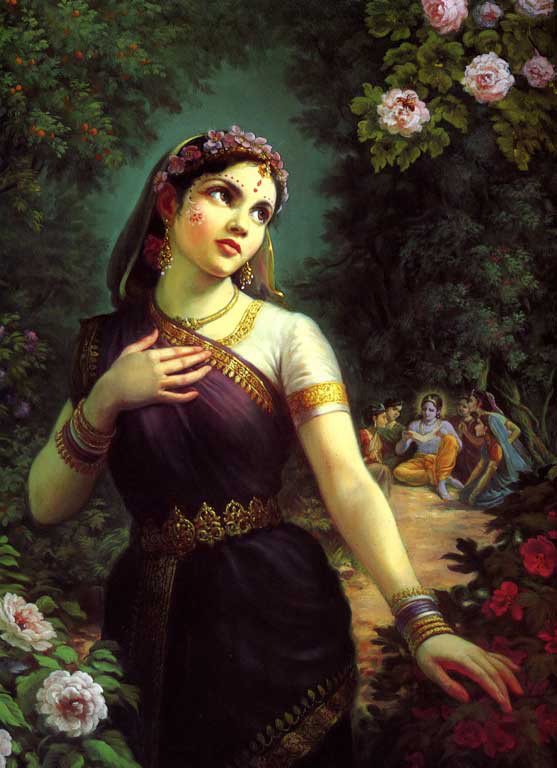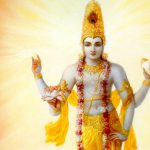Practically every sect of Hinduism chants the gayatri-mantra. While some sects make little of the Bhagavata, all hold high sri gayatri, the sacred hymn of the twice-born. If a connection between gayatri and the Bhagavata can be established, as is suggested in the Garuda Purana (gayatri-bhasya-rupo ‘sau), the Bhagavata’s place in Vedic literature may be unsurpassed. This is precisely what Sri Caitanya intended, and his followers have taken the cue. There is no shortage of theory and evidence among the Gaudiya Vaishnavas in support of this idea.
Vedic evidence itself is, if not abundant, not lacking. Matsya Purana states, as do several Puranas in a similar way, “That is to be known as the Bhagavatam, which basing itself on the gayatri …” (53.20.22). Here gayatri refers to the meaning of the gayatri contained in the word dhimahi (we meditate), which appears in the exact same form in the Bhagavata, both in the beginning (1.1.1) and in the end (12.13.19) as it does in the gayatri-mantra (bhargo devasya dhimahi). The form of the verb dhimahi is distinctly Vedic. The fact that it occurs in the Bhagavata, a Puranic text, is considered by Gaudiya Vaishnavas to be an unmistakable reference to gayatri. That gayatri, the prototype of all mantras, is invoked at the opening and closing of the Bhagavata is significant.
Gayatri is not, however, invoked in full form because the Bhagavata, true to its Puranic purpose of making Vedic truth accessible to the lowborn, does not choose to violate the Vedic injunction that it is improper to speak the gayatri-mantra to the fallen sections of human society. If the gayatri were written in full, the Bhagavata’s Vedic dignity would be violated. Thus, the Bhagavata, seeking as it does to enlighten all regardless of caste (as did Sri Caitanya), states from the beginning that within its pages the meaning of the gayatri will be made accessible to all. Such is the magnanimity of the Bhagavata.
The Agni Purana offers an etymological explanation of the gayatri (beginning in 216.3), and in doing so indicates that the Bhagavata is based on the gayatri-mantra. The following verses from the Agni Purana’s 216th adhyaya, entitled Gayatri-nirvana-kanthana, and the 272nd adhyaya, entitled Purana-dana-dimahatmya-kantha, make clear the connection between the gayatri and the Bhagavata: “The Agni Purana considers the gayatri to be concerned with God alone, who is held therein to be the originator, preserver, and dissolver of the universe. The Bhagavata characterized as it is by the phrase ‘based on the gayatri,’ ever flourishes throughout the land.” Not only does the Agni Purana mention here that the Bhagavata is characterized (by other Puranas) as being “based on the gayatri,” it establishes that gayatri is “concerned with God alone,” as is its commentary, Srimad-Bhagavatam. The emphasis is that gayatri is not, as many think, a mantra propitiating Agni, the fire god, the sun, or any other lesser manifestation of Godhead. It is intended for Bhagavan alone. Thus its connection with the Bhagavata is established, for Srimad-Bhagavatam deals similarly only with the Supreme Lord.
All of the above verses from the Puranas, however, only indicate that the Bhagavata is based on the gayatri and that to some extent it explains the gayatri. As for the gayatri-bhasya, or comprehensive commentary on the gayatri that the Garuda Purana proclaims the Bhagavata to be, we can look to the Vaishnavas and the Gaudiya followers of Sri Caitanya and their commentaries for an explanation.
The Bhagavata, according to Sri Jiva Goswami and Vijayadhvaha of the Madhva school of Vaishnavism, explains itself to be a commentary on the gayatri in its opening stanza. The Bhagavata phrase janmady asya yatah (from whom comes the origin, etc., of the world), for example, describes the ultimate substratum of existence (Vasudeva, Sri Krishna), as does the gayatri in the words tat savitur … devasya (of the divine savitr). Similarly, the Bhagavata’s tene brahma hrda (who revealed the Veda to the heart of Brahma) parallels the gayatri’s dhiyo yo nah pracodayat (may he inspire our intellects). Jiva Goswami’s complete explanation is found in Paramatma-sandarbha.
No doubt the Bhagavata is a comparative study of religious conceptions. All the fourteen worlds of Vedic cosmology (lokas, or dimensions of consciousness) are discussed up to the great, all-encompassing Brahman, along with elaborate descriptions of the spiritual abodes of Vaikuntha, Ayodhya, Dvaraka, Mathura, and Vrindavana, which reside deep within advaya-jnana. The Bhagavata is ultimately a comparison of spiritual tastes (rasas) for spiritual connoisseurs. That the Bhagavata is in effect a course on comparative religion is brought out in detail in Sri Sanatana Goswami’s Brhat-Bhagavatamrta. Is then the gayatri-mantra not also a contemplation (bhur bhuvah svah) of the worlds and beyond (savitur varenyam bhargo devasya dhimahi)? The question remains, how far beyond the world of sense perception, and how deeply within the realm of spiritual perception, gayatri takes one, for it is clear that the Bhagavata does not stop short of the love play of Sri Krishna. According to Sri Caitanya’s followers, as far as the Bhagavata takes us, so does gayatri. In order to explain this, it is necessary to discuss the significance of the Bhagavata as per the Gaudiya Vaishnava tradition, in which the primal svayam sakti of svayam bhagavan, Sri Radha, is so revered.
According to Sri Caitanya’s followers, the Bhagavata speaks only of Sri Radha. This opinion is strikingly in contrast with both the Advaitins and prominent Vaishnava schools as well. The Sri (Ramanuja) and Brahma (Madhva) sampradayas do not see Sri Radha anywhere in the Bhagavata! Neither does Sridhara Swami, who the tradition so reveres, even mention Radha in his original Bhagavata commentary. Although Sri Radha is mentioned in other Puranas, her name is not uttered directly even once in the Bhagavata. Yet the Gaudiyas make much of an indirect reference to her, which Bhaktivinoda Thakura in his Bhagavata arca maricini mala envisions was spoken by Candravali gopi, Sri Radha’s transcendental competitor. This he has no doubt assessed by examining the bhava of this gopi described in the Bhagavata and connecting it with the actual names of the gopis mentioned in other Puranas. The sense that, according to Bhaktivinoda Thakura, Candravali has spoken the verse “anayaradhitam nunam …” is significant, for it says in no uncertain terms that no one but Sri Radha can fully satisfy Sri Krishna. The Padma Purana mentions eighteen thousand gopis among whom 108 are most important. Among those 108, eight are considered more important. Among the eight, two have a special position, Candravali and Radharani. Between the two, Padma Purana tells us Sri Radha is the foremost. But in the Bhagavata, Candravali herself admits this truth as she gazes upon Sri Radha footprints along side of Krishna’s. Candravali admits that Krishna loves her more, for it was she he left the rasa lila for, to be alone with Radha. Thus the Bhagavata is dedicated to explaining the importance of Sri Radha as no other Purana has done.
The Gaudiya Vaishnavas have elaborately explained why this reference to Sri Radha is indirect. They reason that indirect is better than direct, thereby heightening the effect. The Bhagavata covers our direct view of Sri Radha requiring us to look deeply within the text in devotion to see her. Keeping the highest and most esoteric truth hidden from those unqualified (followers of jnana-marg, karma-marg, and vaidhi-bhakti marg) who were assembled at the speaking of the Bhagavata by Sukadeva is offered as another reason for keeping Sri Radha veiled in secrecy. A third reason offered is that Sri Radha, as per the Brahma-vaivarta Purana, was the ista devata of Sukadeva Goswami. If he were to utter her name, he would have lost external consciousness (avista citta) and thus been unable to address the urgent need of Pariksit Maharaja, who had but seven days to live and learn from Sukadeva. Jiva Goswami explains that Sukadeva himself reasoned that if he were to blurt out Radha’s name at the climax of the Bhagavata, the full expression of rasananda would not be served. Because the Bhagavata is first and foremost a book of rasa (muhur aho rasika bhuvi bhavuka), Sukadeva thus refrained from speaking it directly. However, he also reasoned that if he did not reveal her glory, he would be guilty of not distributing one’s acquired knowledge and have to take birth as a brahma raksasa. In order to resolve this dilemma, Sukadeva revealed her name indirectly through Candravali gopi. Other reasons are suggested as well, while at the same time acaryas such as Visvanatha Cakravarti and others are just as prepared to demonstrate how innumerable verses of the Bhagavata are in actuality glorifying Sri Radha.
Sri Jiva Goswami, for example, offers an alternate understanding of the first verse of the Bhagavata in his Krsna-sandarbha, through which he shows that the Bhagavata from the very beginning tells us that its pages are all about the love of Sri Radha for Govinda. Sri Jiva’s rendering of this verse is too beautiful and profound not to mention it in brief. It serves as a deep insight into the mind of Vyasa and his samadhi bhasya, the Bhagavata.
janmady asya yato ‘nvayad itaratas carthenv abhijnah sva-rat
tene brahma hada ya adi-kavaye muhyanti yat surayah
tejo-vari-madam yatha vinimayo yatra tri-sargo ‘mana
dhamna svena sada nirasta-kuhakam satyam param dhimahi
Janmady asya yatah. Janma means manifestation, adyasya means adi or original, yatah means from whom. Who has the original rasa (madhurya) manifested from? From Radha, who is itaratah, distinct from all others, and from Krishna (anvayat). Radha is indirectly the Absolute truth, and Krishna is directly so. Artesu means various pastimes and abhijnah means expert. They are expert in the performance of pastimes. Vyasa, the adi kavi, says the sabda brahma entered my heart (hrda) and I understood through prema bhakti these pastimes (tene brahma hrda ya adi kavaye). When Vyasa sat in meditation under the order of Narada, in a trance of prema bhakti (bhakti yogena manasi samyak prahihite ‘male) this is what he realized, and it is about this, the pastimes of Radha-Krishna, that he wrote in his book the Bhagavata.
Vyasa says that these two, and Sri Radha in particular, are so wonderful. Who can understand them? Even Krishna is bewildered by Radharani, what then can Ananta sesa and others know about her (muhyanti yat surayah)? Land (mrt) turns into water and flows, while water (vari) takes on the character of land and becomes stunned upon hearing the flute of Sri Krishna, which he plays only to attract Sri Radha, whose effulgence (tejah) dims the light of the stars and moon, tejo-vari-mrdam yatha vinimayo.
Among the gopis, there are three kinds: those who favor Radha (headed by Lalita), those who serve in the opposition’s side (headed by Candravali), and those who sometimes take the side of Radha and sometimes the side of Krishna (headed by Visaka). They are all wonderful, yet all three groups (yatra tri-sargo) are insignificant (mrsa) in her presence, yatra tri-sargo mrsa. All have their purpose only in relation to her. Radha’s presence and influence (dhamna) defeats (nirasta) all interference (kuhakam) created by the opposition party, such as that of Jatila and Kutila, and the leader of the gopi opposition Sri Candravali, dhamna svena sada nirasta-kuhakam. Thus their pastimes go on eternally (satyam). Therefore, I meditate (dhimahi) upon these two (param), who are actually one in mahabhava, and one as potent and potency. In this verse Vyasa has described Radha and Krishna in the singular purposefully, and he has used the neuter gender because they are beyond the conceptions of male and female.
If the Bhagavata is about Sri Radha, then there must be an explanation of gayatri that demonstrates the same about itself. There is. Leave it to the followers of Sri Caitanya. In the development of Gaudiya Vaishnavism, the followers of Bhaktivinoda Thakura who followed in the footsteps of the Thakura’s son and disciple, Bhaktisiddhanta Saraswati Thakura, have figured prominently in the worldwide dissemination and popularizing of not only Sri Caitanya’s Vaishnavism but Vaishnavism in general. The work of A. C. Bhaktivedanta Swami Prabhupada, the most prominent disciple of Bhaktisiddhanta Saraswati Thakura, is the most well-known of this lineage. It was Bhaktivedanta Swami Prabhupada also who in effect gave the Bhagavata to the world, in some cases whether they wanted it or not. His disciples’ well-known campaign of airport book selling will not soon be forgotten. And, after all is said and done, I suspect remembered fondly when the pages of the Bhagavata are read and relished. Among Bhaktivedanta Swami Prabhupada’s contemporaries, who after his departure from mortal vision have played prominently in preserving and disseminating Gaudiya Vaishnavism, Srila Sridhara Maharaja is foremost. The extent to which the Bhagavatam is a commentary on the gayatri is brilliantly presented by Pujyapada Sridhara Maharaja in his gayatri bhasya. Originally composed in Sanskrit, it is now available in English. Those further interested in this subject matter will benefit immensely from its study.











